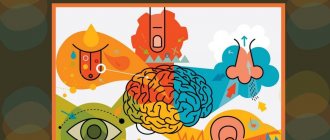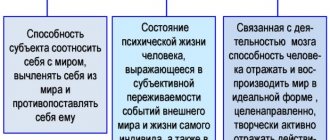Reactivity is one of the main properties of temperament. A person’s behavior in various situations depends on this quality. How do you make decisions: spontaneously, based on emotions, or after careful consideration? The answer to this question will show how developed your reactivity is and whether you can cope with unforeseen situations.
Temperament as perceived by philosophers and scientists of antiquity
Even ancient philosophers argued that a person has a number of characteristics given to him at birth, which are subsequently formed into a set of traits or so-called character. It is impossible to significantly change these features; they can only be easily adjusted under the influence of society and education.
Scientists of that time could not imagine what temperament or character depended on, but they made attempts to substantiate their numerous theories in proportion to knowledge in medicine and psychology. The founder of the typology of temperaments was Hippocrates; he was the first to define each of the types that are still used today. But the famous doctor explained temperament by the predominance of one or another liquid in the human body.
Years later, European scientists tried to put forward their own typology based on the physical characteristics of people. This version was subject to much criticism in the scientific world and is now practically not used.
Temperament through the eyes of Hippocrates and Claudius Galen
Hippocrates defined personality temperaments, and his student and follower Claudius Galen wrote a large scientific treatise, where he described each type in detail and detail, specifying the liquid that is contained in the maximum quantity in human organs.
Based on Galen's theory, there were the following types of human temperament:
- sanguine - this person had a large amount of blood, which influenced his actions and emotions;
- phlegmatic - he was the result of the predominance of phlegm;
- choleric - had increased bile content;
- melancholic - suffered from an abundance of black bile in the body, corroding his internal organs.
Almost until the eighteenth century, this theory was perceived as the only correct one. And only the hard work of modern scientists dispelled the fantastic assumptions of Hippocrates, although the names and characteristics of temperaments have remained unchanged and are actively used.
What did ancient scientists and philosophers think about temperament?
Philosophers and ancient scientists believed that at birth a person receives a set of qualities that determines his future life. It is not possible to completely change qualities. However, they are easy to correct using social influence or education.
First, Hippocrates, and after his student Claudius Gallen, identified and described 4 types of temperament. They differed from each other in the content of special substances in the body:
- Sanguine. There is a lot of blood in the body, the high content of which determines its actions.
- Phlegmatic person. This type of temperament is due to the presence of phlegm.
- Choleric. There is too much bile in the body of such people.
- Melancholic. Filled with black bile, which gradually eats from the inside.
Until the 18th century, this theory was considered the only correct one. In the 21st century, the names of temperament types have remained the same. But the description has changed.
Division into temperaments in modern psychology
Academician Pavlov made a great contribution to the development of psychology. As a result of research, he found out that a person from birth has his own type of nervous system, which determines his behavior. Moreover, this theory is equally effective for animals and people. Subsequently, Pavlov’s research became the basis for the work of Soviet and European psychologists. As a result, a scientifically based typology of human temperaments emerged:
- Sanguine. People of this temperament easily adapt to new conditions, are active and efficient. Most of them are friendly and have high communication skills. They are sensitive to the mood of others and are extroverts.
- Choleric. This temperament characterizes irritable and hot-tempered people. They get distracted from their work very quickly and find it difficult to concentrate. The expression of emotions in choleric people is violent and short-lived; they can also be considered extroverts.
- Phlegmatic person. Such people are very efficient, but it is difficult to switch from one thing to another. They are little emotional and are able to remain calm in any situation. All their movements are slightly slowed down, the same goes for facial expressions. Phlegmatic people are classified as introverts.
- Melancholic. Melancholic people are very sensitive, but not too active. They are touchy, but timid and inhibited. Such people have low productivity and have difficulty meeting new people. The slightest trouble causes violent emotions in them, paralyzing any activity.
To determine a person's temperament, it is necessary to consider him in relation to a number of properties. Psychology has a productive system that allows you to analyze the type of nervous system and classify it.
Main types of temperament
Today in psychology the system of temperaments developed by Academician Pavlov is used. He found out that each person has a special nervous system. She determines how he will behave. Interestingly, the theory applies to humans and animals.
So, according to Pavlov, the description of temperaments looks like this:
- Sanguines. They quickly find a common language with different people. They do not tolerate monotony. Change jobs easily. They speak loudly, actively gesticulating. Has an unstable emotional state. People with this type of temperament develop feelings quickly. But they pass just as quickly.
- Phlegmatic people. They are characterized by slowness, balance, slowness, and calmness. They do not express feelings, they communicate smoothly with others. They have a stable mood. Phlegmatic people cannot be enraged or emotionally hurt.
- Cholerics. They are known for their tendency to hasty speech, excessive mobility, bright facial expressions and gestures. The mood of representatives of this type of temperament changes instantly. They are unbalanced, unrestrained, and do not know how to objectively assess people and the situation around them.
- Melancholic people. They are characterized by a slow course of mental processes. They are passive, not interested in the life around them, withdrawn and often lonely. Feelings in such people develop slowly. However, they differ in depth.
It is noteworthy that in psychology there are no 100% sanguine people or, for example, choleric people. Usually the temperaments are mixed.
Interesting! “A melancholic person will take for a tragedy what a sanguine person will see only as an interesting incident, and a phlegmatic person will see as something not worthy of attention” - Arthur Schopenhauer.
Basic properties of temperament
Defining temperament is impossible without eight aspects that characterize it:
- sensitivity;
- activity;
- ratio of reactivity and activity;
- plasticity and rigidity;
- reaction rate;
- emotional excitability;
- extroversion or introversion.
An experienced psychologist assesses the personality for each aspect and determines the type of temperament. The most important parameters are considered to be reactivity and activity. It’s worth talking about them in more detail.
Reactivity in psychology: definition
It is difficult to say when psychology became a serious science and began to consider a person’s personality taking into account all aspects of temperament. But the scientific community believes that Wolf Solomonovich Merlin was the first to introduce such a concept as reactivity in psychology. This gave impetus to further research into the psycho-emotional differences of individuals, which eventually resulted in a fundamental scientific theory.
At the moment, it can be argued that reactivity in psychology is the uncontrolled reactions of an individual to any stimuli of an external and internal nature. The intensity and duration of these reactions largely determine a person’s temperament. Subsequently, psychologists came to the conclusion that emotional reactivity is responsible for performance and productivity. In psychology, this has acquired particular importance; many large corporations in the West use the concept of reactivity when selecting new personnel.
Reactivity and speed of decision making: is there a relationship?
Based on the results of numerous studies and tests, psychologists have found that the speed of decision-making and reactions to various life situations depends on reactivity.
People with high reactivity often make decisions under the influence of emotions and the moment; many of their conclusions and reactions are incorrect. But in a critical situation, they can save the life of not only one person, but also many others. The same cannot be said about individuals with low reactivity. They think about every decision for a long time and are not able to make it at a specific moment under the influence of stimuli from the outside world.
Signs of emotional reactivity
To understand whether your feelings are emotional reactivity, take a closer look at how you behave in stressful situations. Here are the main signs of this condition:
- you may feel offended by any little thing that seems offensive to you;
- often your reaction does not correspond to the situation. For example, you may be upset because someone gave you a bouquet, and you cannot explain why you are experiencing these emotions. Or be happy about the troubles in your friend’s life, although you really don’t wish her harm;
- you believe that the culprits of your reaction are the events that occur, and not how you yourself interpret them;
- you react sharply to criticism: you actively defend yourself, argue with your opponent, you can easily break off relations with him or turn the argument into accusations and a “slap in the face”;
- at the slightest provocation you experience strong anger and rage, which does not allow you to sensibly assess the situation and make an informed decision;
- you cannot determine a specific trigger for emotional outbursts; any situation can cause this reaction;
- you may feel powerless and guilty because your emotions often get the better of you;
- those around you find you “prickly” and talk about difficulties in communicating with you.
Formula for Reaction Intensity in Emotional Reactivity
Since reactivity in psychology is a reaction to an external stimulus, it would be natural to assume that it has a certain strength. In the modern world, there is even a formula according to which you can determine the degree and intensity of the reaction.
In people with low reactivity, intensity is in direct interaction with the strength of the impact. The more pressure you put on such a person, the more intense his reaction.
Otherwise, everything happens to people who are easily excitable. The intensity of their reaction is absolutely independent of the strength of the impact. Even slight pressure triggers an intense reaction in the individual. This makes highly reactive people unpredictable and difficult to manage.
Types of reactivity
Topic: The role of the body's reactivity in pathology
Reactivity. Definition of the concept
All living objects have the property of changing their state or activity, i.e. respond to environmental influences. This property is usually called irritability.
However, not everyone reacts the same way to the same stimulus. Some animal species change their life activity to external influences differently than other species; some groups of people (or animals) react differently to the same stimulus than other groups; and each individual individually has its own characteristics of response.
Reactivity of the body (from Latin reactia
– counteraction) is the ability of the body to respond in a certain way with changes in life activity to the influence of factors of the internal and external environment.
Reactivity ensures the interaction of the organism with the surrounding world. Reactivity is inherent in all living things. The adaptability of the human or animal body to environmental conditions and the maintenance of homeostasis largely depend on reactivity.
It is the reactivity of the body that determines whether a disease will occur or not when exposed to a pathogenic factor, and how it will proceed.
The study of reactivity and its mechanisms is important for understanding the pathogenesis of diseases and their targeted prevention and treatment.
Examples of manifestations of reactivity at different levels of organization of living objects.
At the molecular level - a shift in the hemoglobin dissociation curve
to the right in conditions of acidosis caused by hypoxia (Bohr effect).
At the cellular level - the implementation of phagocytosis
by leukocytes in response to the introduction of microorganisms into tissues.
At the tissue level – the development of an inflammatory reaction
in response to the action of damaging factors.
At the organ level – an increase in heart rate
with an increase in blood temperature.
At the systemic level - reactions of the external respiration, circulatory and blood systems
during oxygen starvation (hypoxia).
At the level of the organism as a whole, there are complex orienting reactions
in response to sound and light signals.
Types of reactivity
Types of reactivity : specific, group, individual.
Species reactivity is reactivity that is determined by the hereditary anatomical and physiological characteristics of representatives of a given species. This is the most common form of body reactivity.
Species (biological) reactivity is inherent in all individuals of a given species. Species reactivity is formed in all representatives of a given species under the influence of normal (adequate) environmental influences that do not disrupt the homeostasis of the body. This is the reactivity of a healthy body. This reactivity is also called physiological
(primary) - it is aimed at preserving the species as a whole.
Examples of species reactivity: directed movement (taxis) of protozoa and complex reflex changes (instincts) in the life activity of invertebrates (bees, spiders, etc.); seasonal migrations (movements, flights) of fish and birds; seasonal changes in animal activity (anabiosis, hibernation, etc.), features of pathological processes (inflammation, fever, allergies) in different representatives of the animal world.
A striking manifestation of biological reactivity is susceptibility (or immunity) to infection. Thus, canine distemper and foot-and-mouth disease in cattle do not threaten humans. Tetanus is dangerous for humans, monkeys, horses and is not dangerous for cats, dogs, turtles, crocodiles. Sharks do not have infectious diseases, and wounds never fester; rats and mice do not suffer from diphtheria, dogs and cats do not suffer from botulism.
Based on species reactivity, the reactivity of a group of individuals within a species (group) and each individual (individual) is formed.
Group reactivity is the reactivity of individual groups of individuals within one species, united by some characteristic that determines the characteristics of the response of all representatives of this group to the influence of environmental factors.
Such characteristics may include: characteristics of age, gender, constitution, heredity, belonging to a certain race, blood groups, types of higher nervous activity, etc.
The reactivity of the body is related to gender, i.e. with anatomical and physiological differences between individuals. This determines the division of diseases into predominantly female and male, the peculiarities of the occurrence and course of diseases in the female or male body, etc. In the female body, reactivity changes due to the menstrual cycle, pregnancy, and menopause.
For example, diseases such as gout, pyloric stenosis, peptic ulcer of the stomach and duodenum, cancer of the head of the pancreas, coronary sclerosis are more common in men, and rheumatoid arthritis, cholelithiasis, gall bladder cancer, myxedema, and hyperthyroidism are more common in women. The peculiarities of sexual reactivity should be taken into account by the doctor when treating the same diseases in women and men.
People with blood group I (group 0) have a higher risk of developing duodenal ulcers, and those with blood group II have a higher risk of developing stomach cancer and coronary heart disease. People with blood group II (group A) are more sensitive to influenza viruses, but are resistant to the causative agent of typhoid fever. Features of group reactivity are taken into account during blood transfusion.
Representatives of different constitutional types (sanguine, choleric, phlegmatic, melancholic) react differently to the action of the same factors (social, mental).
All patients with diabetes mellitus have a reduced tolerance to carbohydrates, and patients with atherosclerosis have a reduced tolerance to fatty foods. Particular reactivity is characteristic of children and the elderly (which served as the basis for the identification of special sections in medicine - pediatrics and geriatrics).
Individual reactivity is the reactivity inherent in a particular individual. Individual reactivity is determined by the entire complex of features inherent in species and group reactivity, as well as genetic and acquired characteristics during life.
Thus, the impact of any factor (for example, an infectious agent) on a group of people never causes exactly the same changes in life activity in all individuals of this group. For example, during a flu epidemic, some people get seriously ill, others mildly, and others do not get sick at all, although the pathogen is in their body (virus carriage). This is explained by the individual reactivity of each organism.
In the manifestation of individual reactivity, there are cyclical changes associated with the change of seasons, day and night (chronobiological changes). For example, the mortality rate during night operations is three times higher than during day operations. In addition, the optimal time for taking medications should be calculated.
Characteristic changes in the reactivity of the body are detected during the individual life of a person ( in ontogenesis ). Thus, the manifestations of the individual reactivity of the body depending on age can be traced using the example of the formation of an inflammatory reaction.
The ability to develop inflammation in its full extent is formed in an individual gradually, as it develops, proceeding inexpressively in the embryonic period and becoming more pronounced in newborns.
The severity of the inflammatory reaction during puberty (12-14 years) is largely determined by changes that occur in the hormonal system. Susceptibility to pustular infections increases - juvenile acne develops.
Optimal for the life of the body is its reactivity in adulthood, when all systems are formed and functionally complete.
In old age, a decrease in individual reactivity is again observed, which is facilitated by involutive changes in the endocrine system, a decrease in the reactivity of the nervous system, a weakening of the function of barrier systems, the phagocytic activity of connective tissue cells, and a decrease in the ability to produce antibodies. Hence the increased susceptibility to infections.
Thus, individual reactivity is a dynamic, constantly changing property of the organism. From a doctor’s perspective, it is important that this property can be changed purposefully in order to increase the body’s resistance to the action of various pathogenic factors.
Physiological reactivity is reactivity that changes the vital activity of the body under the influence of environmental factors without disturbing its homeostasis; this is the reactivity of a healthy person
body.
Physiological reactivity
– this is a response that is adequate to the nature and intensity of the impact, and also has an adaptive nature.
For example, adaptation to moderate physical activity, thermoregulation systems to temperature changes, the production of digestive enzymes in response to food intake, natural emigration of leukocytes, etc.
Physiological reactivity manifests itself both in individual individuals (in the form of features of physiological processes) and in different species of animals (for example, features of reproduction and preservation of offspring, specific features of heat exchange).
Physiological reactivity varies among individual groups of people. For example, physiological processes such as blood circulation, respiration, digestion, secretion of hormones, etc., are different in children and the elderly, in people with different types of nervous systems.
Pathological reactivity is a qualitatively altered reactivity under the influence of pathogenic factors on the body.
Pathological reactivity
– this is a reaction that is inadequate in terms of severity or the nature of changes in the body’s vital activity, accompanied by a decrease in its adaptive capabilities (for example, an allergic reaction).
Under the influence of pathogenic factors that cause disruption of homeostasis in the body, pathological reactivity occurs, which is characterized by a decrease in adaptability
sick body.
It is also called secondary (or painfully altered) reactivity. In fact, the development of the disease is a manifestation of pathological reactivity
, which is detected both in individuals and in groups and species of animals.
The degree of specificity (differentiation) of the body's response allows us to distinguish between specific and nonspecific reactivity.
Specific reactivity is the body’s ability to respond to the action of an antigen (Ag) by producing antibodies (Ab) or a complex of cellular reactions specific to this antigen, i.e. this is the reactivity of the immune system
(immunological reactivity). Manifestations of specific reactivity: active specific immunity, allergies, autoimmune diseases, immunodeficiency and immunosuppressive conditions, immunoproliferative diseases; production and accumulation of specific antibodies (sensitization), formation of immune complexes on the surface of mast cells.
Nonspecific reactivity - changes in the body that occur in response to external factors and are not related to the immune response
. For example, changes in the body during hemorrhagic or traumatic shock, hypoxia, acceleration and overload; inflammation, fever, leukocytosis, changes in the function of damaged organs and systems in infectious diseases; spasm of bronchioles, swelling of the mucous membrane, hypersecretion of mucus, shortness of breath, palpitations, etc.
The expression of reactivity can be general (formation of immunity, illness, health, changes in metabolism, blood circulation, breathing) and local (for example, in patients with bronchial asthma, increased sensitivity of the bronchi to acetylcholine is detected).
Factors influencing the reactivity of the human body:
• Age. Early childhood is characterized by low reactivity, it gradually increases, becomes maximum in adults, and begins to decrease in old age.
• Floor.
• Heredity.
• Constitution.
• Functional state of the nervous, endocrine, immune systems.
• Environmental factors (climate, diet, social conditions, etc.).
Reactivity in psychology: examples of manifestation in everyday life
In order to have a complete understanding of reactivity, let's give a simple real-life example. Let's say you're dreaming of a vacation after a hard year of work. Your friends are also going to relax, but one goes to the mountains, and the other dreams of a lazy beach holiday in a warm country. Both of them invite you to come with them, but after much deliberation you decide to go on a trip to the sea and the sun. At that moment, when you are ready to voice your decision to a friend, he begins to argue that you must go with him and have no right to do otherwise. This is where your reactivity matters a lot. What will you do? Will you begin to resist the pressure and abandon your already planned and much-desired vacation on the beach, going to the mountains as a protest? Or stick to the original plan, no matter the pressure put on you?
People who are capable of doing harm to themselves are characterized by increased reactivity and often draw the wrong conclusions from the situation. Moreover, the opponent’s personality does not play a role in making a decision; it can be a close friend or a stranger. A tendency to make hasty and incorrect decisions is revealed in those people who have increased reactivity. In psychology, this is considered to be a constant, which is used as a starting point in determining a person’s temperament.
How reactivity manifests itself in everyday life
Let's imagine a familiar situation. Let's say you have two friends with whom you are planning to spend a vacation. Suddenly one expresses a desire to go to the mountains. Another is not a supporter of active recreation, so he suggests going to the sea. Each of them calls you with them.
You thought for a long time and decided to lie on the beach. Of course, the first friend will not like this decision. And this is where reactivity starts to work. How will you respond to calls to drop everything and enjoy the beauty of the mountains? Will you try to cope with the pressure and follow your desires, preferences and plan? Or, as a sign of protest, cancel your trip to the sea and go to the mountains?
If you are highly reactive, you are likely to step on your own desires and act on your friend's desires. By the way, such hasty decisions do not depend on who they are made for. It could be a relative or even a stranger.
Reactivity and activity: features of the relationship
It has long been proven that the productivity of any human activity is determined by the ratio of reactivity and activity. In psychology, this was expressed in several formulas that emerged as a result of special and lengthy research. Highly reactive individuals have little activity, since they cannot work with concentration and are constantly distracted by the slightest external stimuli. In addition, this type is also affected by internal stimuli - thoughts, emotions, memories. All this significantly reduces labor productivity.
Individuals with low reactivity usually have the highest activity. They are able to solve one problem until a result is achieved, without being distracted by anything in the world around them. Such people are able to work for weeks and months until they get what they want. Scientists who have given the world great discoveries are often classified as this type.
The psychological reactions of many people cannot be controlled, but with certain knowledge, it is possible to predict a person’s behavior and draw conclusions about his capabilities on the way to the top of his career.
How to Deal with Emotional Reactivity
Of course, it is impossible to completely control your emotions, and it is not necessary. However, in the case of emotional reactivity, it is important to learn to work with this condition in order to feel better and improve relationships with others. Here's what will help you do it.
Know your triggers
To become less emotionally reactive, you need to understand what exactly makes you react this way.
To do this, you can write down situations in which you showed your feelings in this way and look for repeating ones. This could be criticism of what you do, or even the way your colleague speaks if you are discussing work problems. The better you know your triggers, the easier it will be for you to respond calmly next time.
Understand how you feel
To cope with emotional reactivity, you need to understand exactly what you are experiencing in the situation. Give a clear definition of emotions, even if you experience several at once.
For example, you may feel angry and resentful after hearing criticism. Or disappointment that leads to tears in case of failure. Or anger that someone doesn't live up to your expectations.
It can be helpful to keep an emotional diary if you experience reactivity frequently. This way you can identify those that appear most often and learn to deal with each one separately. For example, dealing with anger or working on self-esteem.
And such a diary will also come in handy if you decide to see a psychotherapist. This will make it easier for the doctor to understand you and track the dynamics and causes of reactive emotionality.
Learn to pause
You can learn meditation to slow down and calm down. To know where to start, read this material - in it we talked about 3 rules of meditation for beginners.
Try to use as much strength as possible to slow down and calm down before expressing your opinion or reacting in any way to an acute situation.
For example, if you realize that your loved one's words have made you angry, ask them for a few minutes to calm down. Leave the room, take a few deep breaths.
Or if you want to cry because of a stranger’s remark, also mentally stop and bring yourself to your senses. Concentrate on what is happening around you to distract yourself and redirect your attention. Also remind yourself that your feelings are reactive, and may actually have nothing to do with the present state of affairs.
The main thing to remember is that it is better to take a short time out and discuss the situation calmly than to immediately rush into an argument because of surging feelings.
Take responsibility for your feelings instead of blaming other people
Instead of blaming other people, try to acknowledge your feelings and take responsibility for them.
For example, if a friend didn’t call you even though you agreed to do so, don’t tell her, “I’m so angry that I didn’t get a call from you.”
Say something different about your feelings: “Yesterday you didn’t call me and it made me feel unwanted. This upset me greatly. Next time, if you don’t have time to call me, please send me an SMS.”
Firstly, such a conversation is more constructive. And secondly, your friend will probably understand the reason for your feelings and next time will pay more attention to fulfilling her promise.









